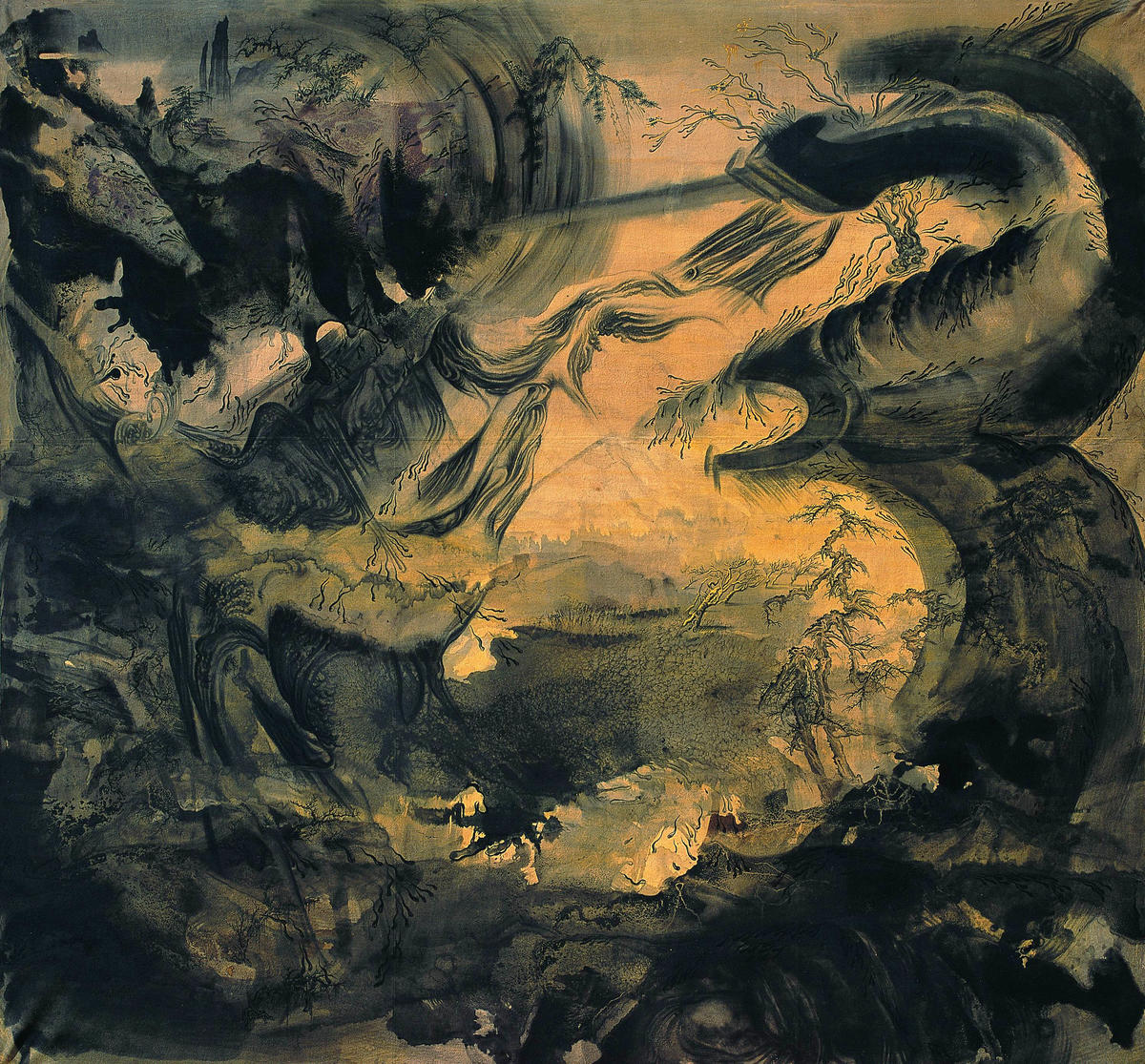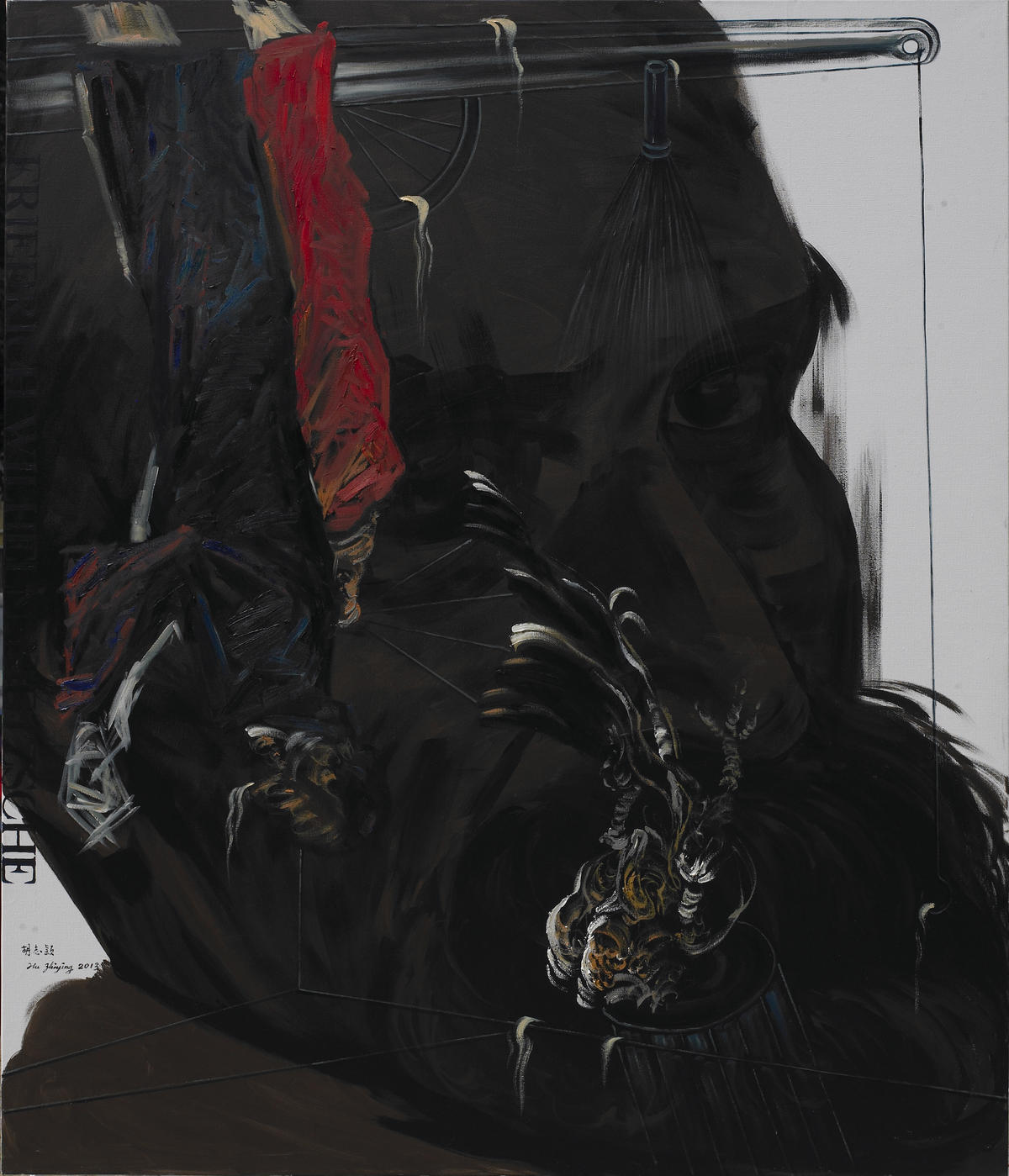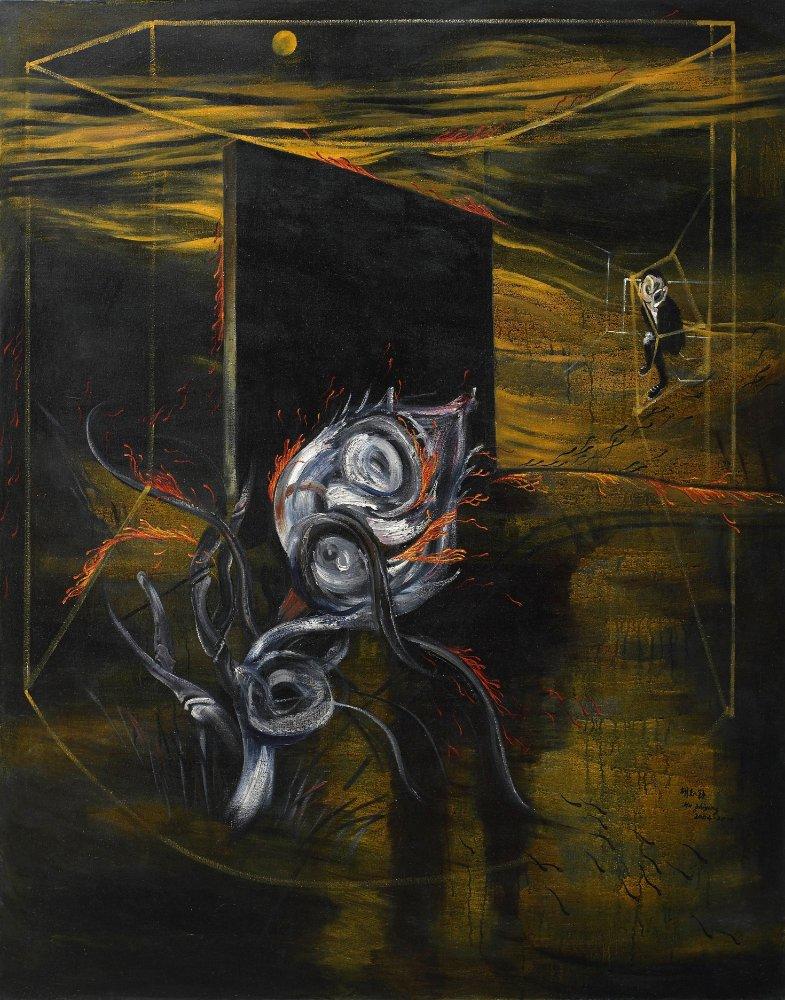当代绘画之多元文化的时代精神
[美] 埃德·麦科马克
当代绘画之多元文化的时代精神
[美] 埃德·麦科马克
 胡志颖 白月(2) 2010,布上油彩、丙烯、大漆,206×163cm HU ZHIYING White Moon(2), 2010, oil acrylics, lacquer on canvas, 206×163cm
胡志颖 白月(2) 2010,布上油彩、丙烯、大漆,206×163cm HU ZHIYING White Moon(2), 2010, oil acrylics, lacquer on canvas, 206×163cm
我写这篇文章表达我对中国艺术家胡志颖的作品的专业见解,以期令人信服地向美国当代艺术领域表明,正如先于他出生的艺术家威廉 · 德 · 库宁、 希尔 ·高尔基和其他外国出生的艺术家,胡志颖的艺术将成为我们文化的宝贵财富,因为他已经确立了自己在其领域作为极其重要的艺术家的地位。
想明确说明,我第一次看到胡志颖的绘画作品是在2009年,曼哈顿切尔西艺术区国际美术馆为他举办的展览,他的艺术从我尤为难忘的诸多视觉经验中脱颖而出。其中的原因之一是他的作品符合当代绘画之多元文化的时代精神,他真正创造性地综合了东方与西方的美学。胡志颖系列作品与著名的英国艺术家弗朗西斯·培根开展艺术的对话,立即打动了我,这位天才的中国画家赞扬培根的同时,又不牺牲任何自己的独创性。

胡志颖 内典录之八,绢上丙烯,墨,木炭,植物颜料,183×195cm HU ZHIYING Buddhist Scriptures Ⅷ,1999-2003, acrylic, ink, charcoal, plant pigment on silk, 183×195cm
以英国画家的形式语汇为出发点,胡志颖给纽约艺术观众上了不同寻常的一课:西方艺术与东方艺术有关审视诸如独创性和传统的观念的方式极其不同。他以大致相同的方法吸纳培根抽搐的风格语汇和传统的中国艺术家所遵循的范本《芥子园画谱》(绘画入门书,其中概括了用特定的笔画描绘树的四枝、崎岖山峰的表面,等等),能动地把他们转化为表达他自己的艺术意旨。
胡志颖使对比更为强烈,将他称为“重造培根”系列作品中,与其他混合媒介绘画作品并列,实际上是通过巧妙地从《芥子园画谱》掇取图式,叠加在西方风格的风景画中,他显示了一种流动的不确定性绘画性语言,从而拓展了盛行的后现代思潮称之为“挪用艺术”的可能性。
胡志颖艺术观念的智慧和审美在这次展览中,立即强烈地向在场的我昭示其罕见和潜在的重要天赋。胡志颖“内典录”系列作品,其中他将传统中国水墨画的大多是单色调画面的蜿蜒笔画、空间张力与豪放的美国抽象表现主义(其自身部分受到古代中国和日本的禅宗文人画家的自发性意念的影响)的粗狂笔触、能量相结合,给我同样深刻难忘的印象。
(埃德·麦科马克:纽约《画廊与工作室》杂志总编)

胡志颖 哲学家档案——尼采 2013,布上油彩、丙烯,200×170 cm HU ZHIYING Philosopher Achieve---FRIEDRICH WILHELM NIETZSCHE, oil, acrylics on canvas, 200×170 cm
Multicultural Zeitgeist of Contemporary Painting
By Ed McCormack
I am writing this article to express my professional opinion of the works of the Chinese artist Hu Zhiying, in the hope of convincing American contemporary art field that, like Willem de Kooning, Arshile Gorky, and other foreign-born artists before him, he would become a valuable asset to our culture, as he has already established himself as a leading artist in his field.
 HU ZHIYING Remake Bacon --- Bat and Rose (1) 2004—2005, oil, acrylic, lacquer on canvas, 196×153cm
HU ZHIYING Remake Bacon --- Bat and Rose (1) 2004—2005, oil, acrylic, lacquer on canvas, 196×153cm
In the latter regard, I wish to state unequivocally that the paintings of Hu Zhiying, which I first encountered in his exhibition at World Fine Art Gallery, in the Chelsea art district of Manhattan in 2009, stand out among my more memorable viewing experiences. One of the reasons for this is that his work is truly in tune with the multicultural zeitgeist of contemporary painting for its innovative synthesis of Eastern and Western aesthetics. This was what struck me most immediately about Hu Zhiying’s series of paintings initiating an artistic dialogue with the famous British artist Francis Bacon, in which this gifted Chinese painter paid tribute to Bacon without sacrificing any of his own originality.
 HU ZHIYING Lingshan Mountains---Memory of My Mother (3), 2007, oil, acrylics and lacquer on canvas, 196×153 cm
HU ZHIYING Lingshan Mountains---Memory of My Mother (3), 2007, oil, acrylics and lacquer on canvas, 196×153 cm
Taking the British painter’s formal vocabulary as a point of departure, Hu Zhiying gave the New York art audience an object lesson in the very different way such notions as originality and tradition are viewed in Eastern art than in the art of the West. For he adopted Bacon’s stylistic tics in much the same way that traditional Chinese artists employ the conventions of The Mustard Seed Manual (the painting primer that outlines the specific strokes for depicting tree-limbs, craggy mountain surfaces, and so on), turning them dynamically to his own purposes. Hu Zhiying drove the point home even more forcefully by juxtaposing the “Remake Bacon” series, as he called it, with other mixed media paintings in which, by skillfully superimposing actual motifs from the Mustard Seed Manual over landscapes painted in the Western manner, he displayed a painterly fluidity that expanded the possibilities of the popular postmodern trend called “Appropriation Art.”
 HU ZHIYING Mr Don Quijote II, 2014, oil, acrylics on canvas, 160×190 cm
HU ZHIYING Mr Don Quijote II, 2014, oil, acrylics on canvas, 160×190 cm
Hu Zhiying’s conceptual wit and aesthetic élan in that first exhibition immediately indicated to me that I was in the presence of a rare talent. I have since been equally impressed by the works in Hu Zhiying “Buddhist Scriptures” series, in which he combines the sinuous strokes, spatial expansiveness, and mostly monochromatic palette of traditional Chinese ink painting with the gestural sweep, energy, and large scale of American Abstract Expressionism (itself influenced in part by the spontaneity of the Zen literati painters of ancient China and Japan)
(Ed McCormack: The director of Gallery & Studio Magazine, New York)